
New York City's Wastewater Treatment System
New York City's Department of Environmental Protection
The Department of Environmental Protection supplies water to the city, and then collects and treats a combination of sewage waste and runoff from rain and snow. The wastewater is collected through a grid of 11,900 kilometers (or 7,400 miles) of sewer pipes. The system collects 4.9 million cubic meters (or 1.3 billion gallons) of liquid every day. 96 pump stations move the wastewater to 14 treatment plants.
CrotonAqueduct
New York has had a sewer system since the mid 1800s. The Croton Aqueduct opened in 1842. New Yorkers were using more water, but taking much less from wells and cisterns. This raised the water table and flooded cellars.
The Croton Aqueduct was a system, while the sewers were built piecemeal under ward leaders who retained control. For example, there was a sewer running along Canal Street in the 1830s. It was an open channel, sixteen feet wide and running down the center of the street. The 6th Street and 9th Street sewers were even wider, twenty feet, and so they moved even slower.
In 1845 the Common Council changed their policy and allowed a mix of animal, vegetable, and human waste to enter the city's sewer systems. The city started building sewers, starting in the tenement areas where cellar flooding was worse. This was in contrast to the fresh water supply, which was routed to the wealthier sections first.
It had been thought that "The innate immorality of the poor condemned them to a life of filth, degradation and disease." By around 1850 the city was questioning that philosophy.
By 1852 there were 148 miles of sewers. In 1854 a new city regulation stated that a household must connect if there is a sewer line available. By 1855 the sewers extended from the Battery at the southern tip of Manhattan uptown as far as 60th Street.
Epidemiology On the Mode of
Communication
of Cholera
John Snow had shown that septic waste leaking into water supplies led to cholera epidemics in London. The excreta of cholera victims was infectious, it wasn't the ill-defined "miasma" cited by medical authorities up to that point. The second edition of his book On the Mode of Communication of Cholera came out in 1855.
Snow's book was very influential. It is still cited in formal study of epidemiology. Meanwhile, in 1855 the Illinois state legislature hired Ellis Chesbrough of Boston to design and build a sewer system in Chicago. In 1857 the New York state legislature established the Brooklyn Board of Sewer Commissions and called for it "to devise and carry into effect a plan of drainage and sewerage for the whole city, upon a regular system, for the purpose of carrying off the water and filth proper to be carried off in sewers, for the health and convenience of the inhabitants." Brooklyn's engineers, Julius Adams and J. P. Kirkwood, divided Brooklyn into four divisions. The sewerage of each district was planned, financed, and built as an integrated system.
Amazon
ASIN: 1557530955
For more on the earlier decades of New York's sewer systems, see Building New York's Sewers: The Evolution of Mechanisms of Urban Development by Joanne Abel Goldman, published by the Purdue University Press.
The age of New York's system means that it is a combined sewer system in which rainwater and septic waste flow into the same system of pipes. This greatly increases the amount that must be handled during rainy weather. If you were building a new system you would very much prefer to have separate rainwater runoff and sewage lines.
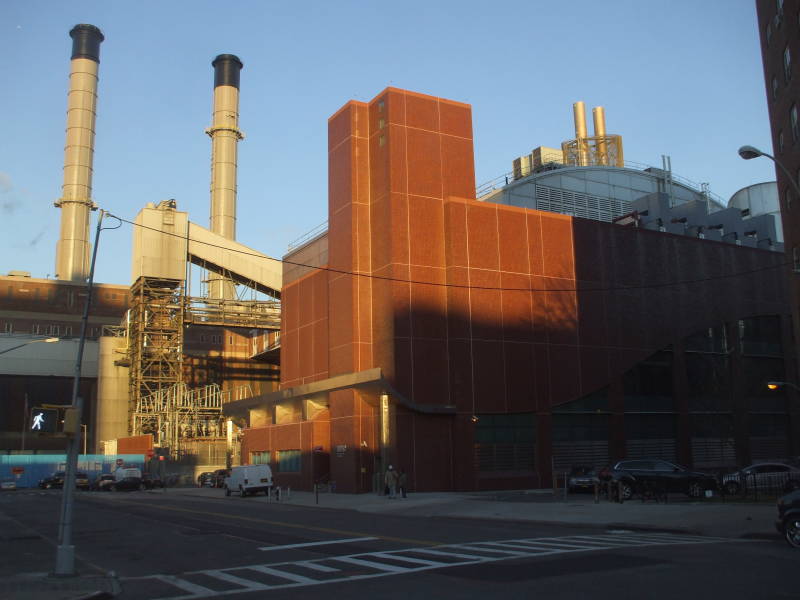
Thirteenth Street Pumping Station, on Avenue D between 12th Street and 13th Street.
New York had to deal with an older system with a lot of liquid and semi-liquid waste. Starting in 1924, the city hauled sludge by barge and tugboat to a point 12 miles offshore in the Atlantic Ocean. That continued until 1986, when it was hauled further out, to a point 106 nautical miles out from Atlantic City. Ocean dumping was then banned in 1992.
The original parts of the Jamaica plant were built in 1903. This makes it the oldest of the current 14 wastewater treatment plants in New York City. The system was expanded in the 1930s through the 1950s. The Coney Island plant was built in 1935, Wards Island in 1937, and Bowery Bay and Tallman Island in 1939. Then the Jamaica plant was expanded in 1943 and the 26th Ward plant was built in 1944. The Rockaway, Hunts Point, and Owls Head plants were built in 1952, Port Richmond in 1953, and Oakwood Beach in 1956. The Newtown Creek plant opened in 1967. Two more were added in the 1980s: North River in 1986 and Red Hook in 1987.
"Sewage contamination in the New York Bight"Until the North River plant started its preliminary treatment in March 1986, the city of New York had always discharged raw sewage directly into the Hudson River. The extent is measured in the 1979 paper "Sewage contamination in the New York Bight: Coprostanol as an indicator".
Scientists have used coprostanol and other fecal steroids to discover sewer systems in the Agora of Athens from the late 500s CE, to track Hannibal's forces through the Alps by the remains of the elephant droppings, and to track the first human inhabitants of North America.
Wastewater Treatment Plants of New York City
| Plant, service area | ||||
| Service area people / km2 |
Capacity m3/day |
Discharge | Opened | |
|
Newtown Creek —
Southern Manhattan,
east Midtown Manhattan, northeastern Brooklyn, western Queens |
||||
| 1,069,000 | 63.5 | 1,800,000 | East River | 1967 |
| North River — Western Manhattan north of Bank Street | ||||
| 589,000 | 24.3 | 640,000 | Hudson River | 1986 |
| Wards Island — Upper East Side of Manhattan, western Bronx | ||||
| 1,062,000 | 48.7 | 1,040,000 | Upper East River | 1937 |
| Hunts Point — Eastern Bronx | ||||
| 685,000 | 67.3 | 760,000 | Upper East River | 1952 |
| Bowery Bay — Northeastern Queens | ||||
| 849,000 | 61.6 | 570,000 | Upper East River | 1939 |
| Tallman Island — Northeastern Queens | ||||
| 411,000 | 68.1 | 300,000 | Upper East River | 1939 |
| Red Hook — Northwestern Brooklyn and Governor's Island | ||||
| 193,000 | 12.9 | 230,000 | Lower East River | 1987 |
| Owls Head — Western Brooklyn | ||||
| 759,000 | 52.3 | 450,000 | Upper New York Bay | 1952 |
| 26th Ward — Eastern Brooklyn near Jamaica Bay | ||||
| 284,000 | 23.8 | 320,000 | Jamaica Bay | 1944 |
| Coney Island — Southern and central Brooklyn | ||||
| 597,000 | 61.1 | 420,000 | Jamaica Bay | 1935 |
| Jamaica — Southern Queens | ||||
| 729,000 | 102.6 | 380,000 | Jamaica Bay | 1903 |
| Rockaway — Rockaway Peninsula | ||||
| 91,000 | 25.4 | 170,000 | Jamaica Bay | 1952 |
| Port Richmond — Northern Staten Island | ||||
| 199,000 | 39.1 | 230,000 | Kill Van Kull | 1953 |
| Oakwood Beach — Southern Staten Island | ||||
| 245,000 | 43.5 | 150,000 | Lower New York Bay | 1956 |
Sewage Treatment
The liquid flowing through the pumping stations and pipes to the fourteen treatment plants contains a wide variety of material. Some is household waste, from toilets, baths, sinks, and washing machines. Restaurants and hotels contribute similar waste. Industrial and commercial facilities add even more. Finally, there is rainwater and other liquid runoff.
Pretreatment
Screens on storm drains keep large objects out of the system. Once the waste arrives at the plant, further screens are used to remove bottles, cans, bags, tree limbs, mob hits, and other bulky objects.
Primary Treatment
The primary sedimentation stage puts the waste into large tanks or pools. Denser material settles into sludge at the bottom, while oil floats to the top. The idea is to let gravity do the work of separating impurities out of the water. The liquid moves slowly through a series of primary treatment basins, becoming cleaner along the way.
Oil and grease is skimmed off the surface. Sometimes air is blown into the bottom of the tank to carry oil to the surface as foam. Mechanical arms scrape along the bottom, moving sludge into hoppers for further treatment.
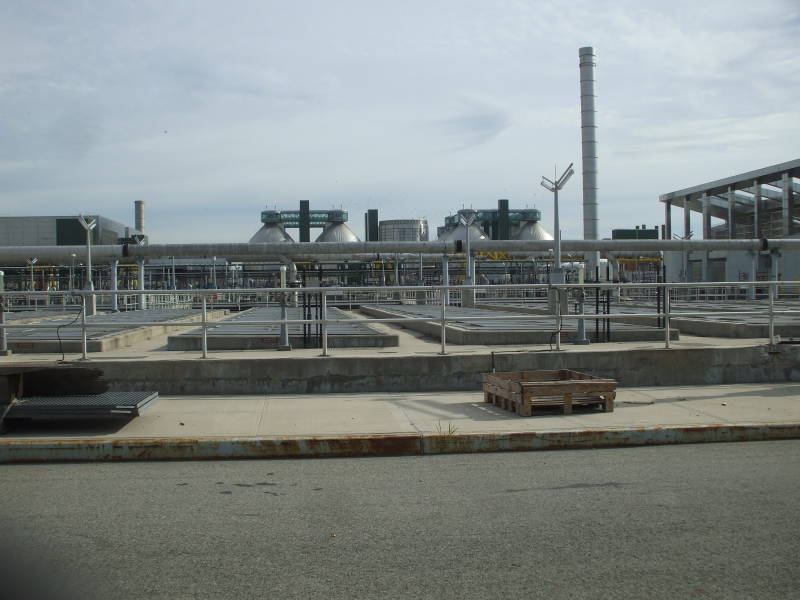
Newtown Creek Wastewater Treatment Plant: sedimentation tanks in the foreground, aeration tanks beyond, digestion chambers in the background.
Secondary Treatment
The secondary stage pits biology against biology. Aerobic or oxygen-using bacteria and protozoa consume and break down the soluble sugars, fats, and other short-chain carbon molecules. They bind larger and less soluble molecules into floc, which settles out of suspension into sediment.
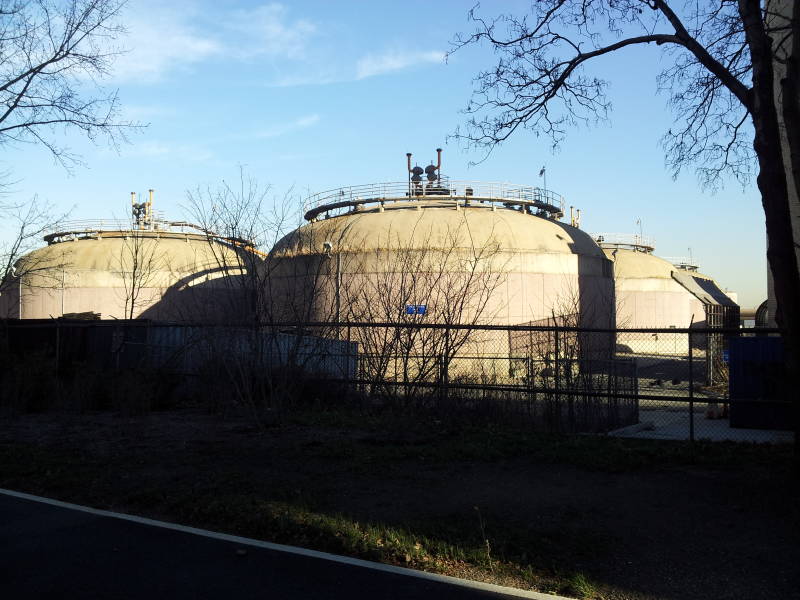
Sludge treatment at the Wards Island Wastewater Treatment Plant.
Anaerobic digestion breaks down chemicals in the absence of oxygen. Different strains of microorganisms are used in heated digestion chambers. The amount of solid waste is further reduced, and useful methane is produced.
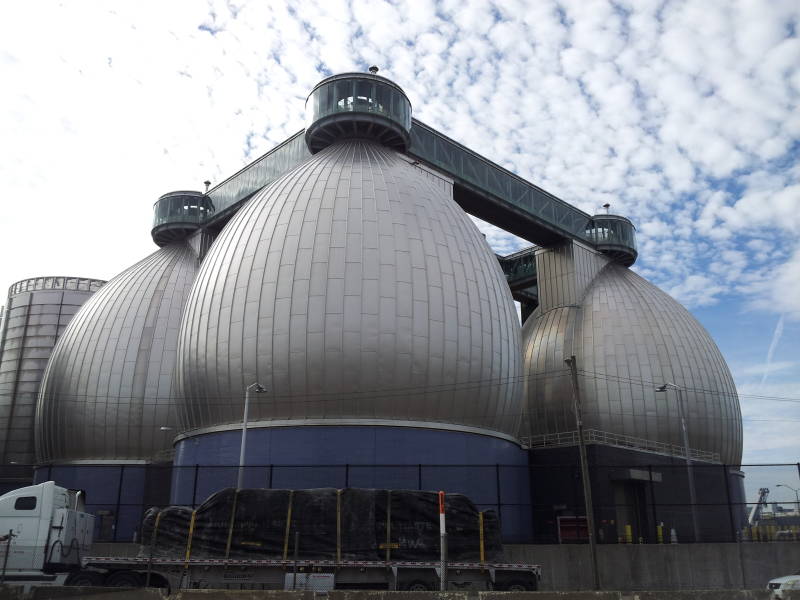
The famous anaerobic "Digester Eggs" at the Newtown Creek Wastewater Treatment Plant.
Tertiary Treatment
Various microorganisms oxidize ammonia (or NH3) in the wastewater into nitrite (or NO2-) and then to nitrate or NO3-. Others then reduce the nitrate to nitrogen gas (or N2), which diffuses into the atmosphere.
Phosphorus leads to troublesome blooms of algae where the plant's output is released. It comes from human urine and feces plus detergents. Specific bacteria collect phosphorus, to the point that it makes up 20% of their mass. The resulting biomass can be separated from the water, yielding a useful fertilizer.
Dewatering and Biosolids
The final stage of sludge treatment is dewatering, to convert the sludge to biosolids, a moist soil-like material that can be used as fertilizer or as a soil replacement.
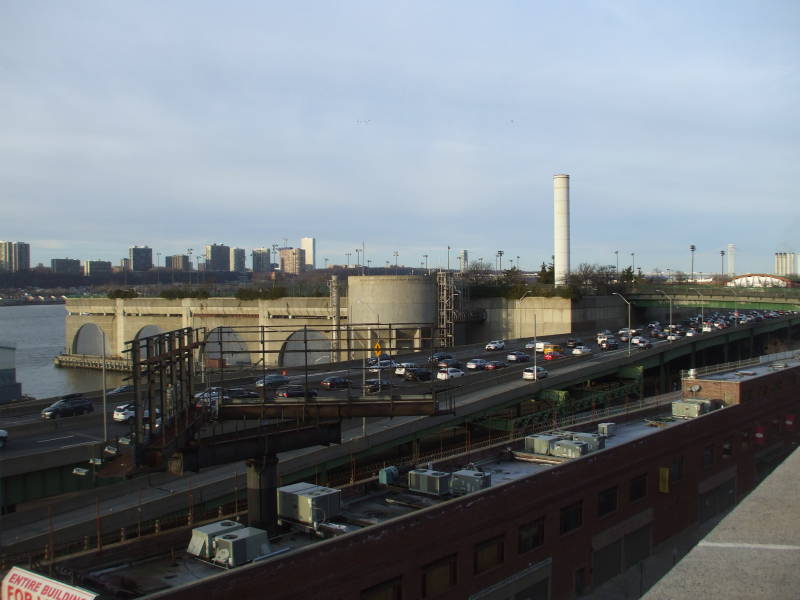
The North River Wastewater Treatment Plant disinfects its effluent with sodium hypochlorite before releasing it into the lower Hudson River.
Disinfection
The final stages of tertiary treatment for the remaining water can use either ultraviolet light or chemicals (typically ozone, chloramine, chlorine, or sodium hypochlorite) to reduce the population of microorganisms before the liquid is released into the environment.